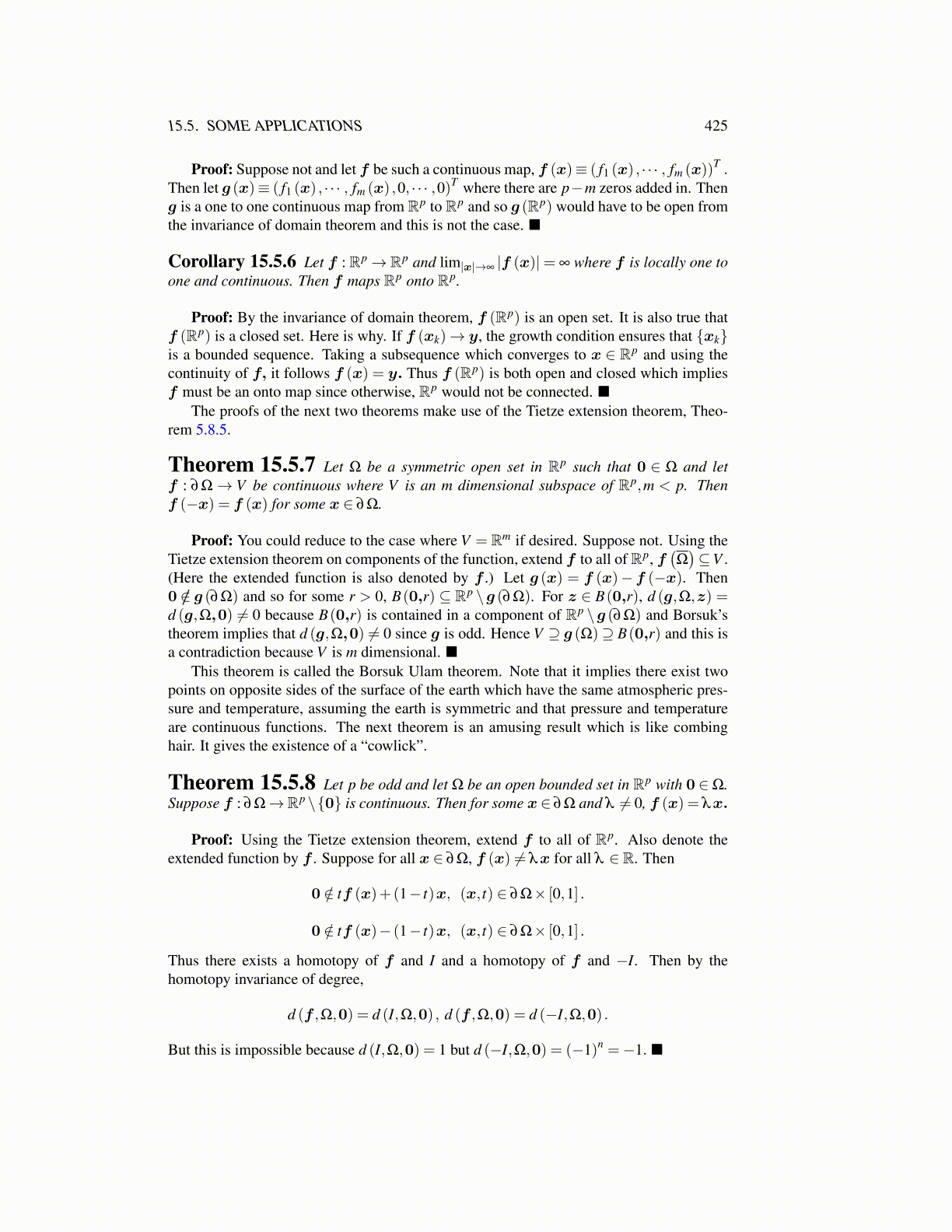
15.5. SOME APPLICATIONS 425
Proof: Suppose not and let f be such a continuous map, f (x)≡ ( f1 (x) , · · · , fm (x))T .Then let g (x)≡ ( f1 (x) , · · · , fm (x) ,0, · · · ,0)T where there are p−m zeros added in. Theng is a one to one continuous map from Rp to Rp and so g (Rp) would have to be open fromthe invariance of domain theorem and this is not the case. ■
Corollary 15.5.6 Let f : Rp→ Rp and lim|x|→∞ |f (x)|= ∞ where f is locally one toone and continuous. Then f maps Rp onto Rp.
Proof: By the invariance of domain theorem, f (Rp) is an open set. It is also true thatf (Rp) is a closed set. Here is why. If f (xk)→ y, the growth condition ensures that {xk}is a bounded sequence. Taking a subsequence which converges to x ∈ Rp and using thecontinuity of f, it follows f (x) = y. Thus f (Rp) is both open and closed which impliesf must be an onto map since otherwise, Rp would not be connected. ■
The proofs of the next two theorems make use of the Tietze extension theorem, Theo-rem 5.8.5.
Theorem 15.5.7 Let Ω be a symmetric open set in Rp such that 0 ∈ Ω and letf : ∂Ω→ V be continuous where V is an m dimensional subspace of Rp,m < p. Thenf (−x) = f (x) for some x ∈ ∂Ω.
Proof: You could reduce to the case where V = Rm if desired. Suppose not. Using theTietze extension theorem on components of the function, extend f to all of Rp, f
(Ω)⊆V .
(Here the extended function is also denoted by f .) Let g (x) = f (x)− f (−x). Then0 /∈ g (∂Ω) and so for some r > 0, B(0,r) ⊆ Rp \g (∂Ω). For z ∈ B(0,r), d (g,Ω,z) =d (g,Ω,0) ̸= 0 because B(0,r) is contained in a component of Rp \g (∂Ω) and Borsuk’stheorem implies that d (g,Ω,0) ̸= 0 since g is odd. Hence V ⊇ g (Ω)⊇ B(0,r) and this isa contradiction because V is m dimensional. ■
This theorem is called the Borsuk Ulam theorem. Note that it implies there exist twopoints on opposite sides of the surface of the earth which have the same atmospheric pres-sure and temperature, assuming the earth is symmetric and that pressure and temperatureare continuous functions. The next theorem is an amusing result which is like combinghair. It gives the existence of a “cowlick”.
Theorem 15.5.8 Let p be odd and let Ω be an open bounded set in Rp with 0 ∈Ω.Suppose f : ∂Ω→Rp \{0} is continuous. Then for some x ∈ ∂Ω and λ ̸= 0, f (x) = λx.
Proof: Using the Tietze extension theorem, extend f to all of Rp. Also denote theextended function by f . Suppose for all x ∈ ∂Ω, f (x) ̸= λx for all λ ∈ R. Then
0 /∈ tf (x)+(1− t)x, (x, t) ∈ ∂Ω× [0,1] .
0 /∈ tf (x)− (1− t)x, (x, t) ∈ ∂Ω× [0,1] .
Thus there exists a homotopy of f and I and a homotopy of f and −I. Then by thehomotopy invariance of degree,
d (f ,Ω,0) = d (I,Ω,0) , d (f ,Ω,0) = d (−I,Ω,0) .
But this is impossible because d (I,Ω,0) = 1 but d (−I,Ω,0) = (−1)n =−1. ■